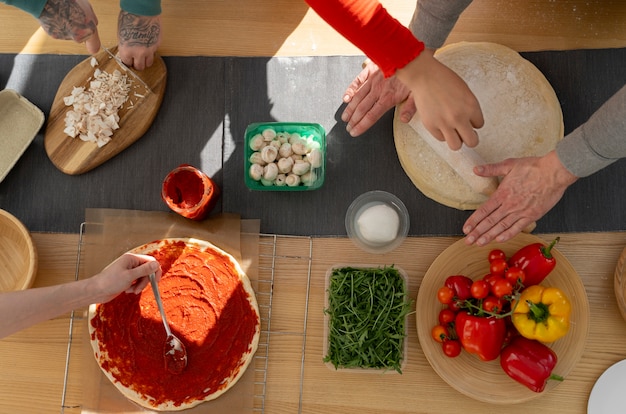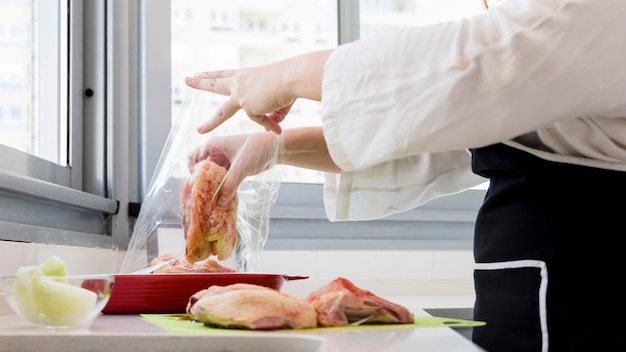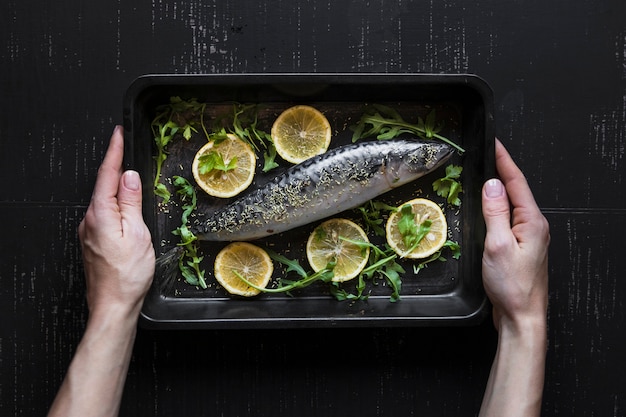Let's be honest, sometimes we're all guilty of grabbing a frozen salmon fillet when dinner time rolls around and inspiration is lacking. But before you write off frozen salmon as a culinary dead end, let me tell you, it's a versatile and delicious ingredient when cooked right. This article is your guide to transforming those frozen slabs of fish into a truly satisfying meal. We'll delve into the best cooking times, explore essential tips for achieving juicy and flavorful results, and even uncover some of my favourite flavour combinations. So, grab your baking sheet, gather your spices, and let's get cooking!
(Part 1) Frozen Salmon: A Culinary Lifeline for the Busy Cook

I confess, I used to be a bit snobbish about frozen salmon. I'd see those glistening fresh fillets at the fishmonger's and think, "I could never achieve that at home." But then reality hit. I'm a busy person, and frozen salmon became my culinary lifeline. It's always there, ready to be thrown into a pan or oven when a quick and healthy meal is needed.
The real challenge, however, was figuring out how to cook it properly. I'm a bit of a perfectionist, and I have a deep aversion to dry, overcooked fish. It's a sensory nightmare, I tell you! So, I started experimenting. I tried different cooking methods, temperatures, and timings. It wasn't always pretty (there were a few unfortunate incidents involving over-cooked salmon!), but I eventually stumbled upon some foolproof techniques that consistently deliver delicious results.
(Part 2) Thawing and Preparation: The Foundation of Flavor

Thawing: A Gentle Awakening
Let's get one thing straight: you can't just chuck a frozen salmon fillet straight into the oven. That's a recipe for disaster! You've got to thaw it first, and the best way to do that is in the refrigerator. Allow at least 24 hours for a whole salmon, or about 6-8 hours for individual fillets.
I know, I know, "That's a long time!" you might be thinking. But trust me, thawing in the refrigerator is the key to achieving a moist and tender result. It allows the fish to thaw evenly, minimizing the risk of overcooking. Think of it as giving your salmon a gentle awakening, prepping it for the delicious journey ahead. Plus, planning ahead always makes for a more relaxed cooking experience, don't you think? It gives you time to pick out your favourite side dish and contemplate the perfect flavour combination for your salmon.
Preparing for the Oven: A Simple Yet Crucial Step
Once your salmon is thawed, it's time for a little pre-oven prep. This is where things get really simple, no fancy techniques required. First, I pat the salmon fillets dry with kitchen paper. This helps to remove excess moisture, which can lead to steam and a soggy texture. Next, I drizzle a bit of olive oil over the fish. It adds flavor and helps to create a lovely golden crust in the oven.
Now, this is where you can get creative! You can season your salmon with pretty much anything you like. Salt and pepper are always a good start, but don't be afraid to get adventurous. I love to use a blend of herbs like thyme, rosemary, and dill. You could also add some lemon zest, garlic powder, or paprika for a bit of extra flavour. The possibilities are endless!
(Part 3) Oven-Baked Frozen Salmon: A Step-by-Step Guide

Choosing Your Oven: Gas or Electric
Okay, so you've got your thawed salmon, it's prepped and ready to go. Let's talk about the oven. I usually use my trusty electric oven, but a gas oven will work just as well. The main difference is the heat distribution. Gas ovens tend to have more even heat, while electric ovens can sometimes have hot spots. Don't worry too much about this, though, just keep an eye on your salmon as it cooks.
Preheating for Perfection: The Key to Even Cooking
One of the most important things when cooking any fish is to preheat your oven. It ensures that the heat is evenly distributed, allowing the salmon to cook evenly and avoid any cold spots. I always preheat my oven to 180°C (350°F). A nice, consistent heat is crucial for achieving a perfectly cooked salmon.
Baking the Salmon: A Simple Journey to Deliciousness
Now, here comes the fun part - baking the salmon! I usually line a baking sheet with some baking parchment paper. It makes cleaning up a breeze. And remember that drizzle of olive oil? You can use a little more now if you like. A bit of extra oil helps to prevent the salmon from sticking to the parchment paper.
Then, it's time to place the salmon fillets on the baking sheet, leaving a little space between each one. Now, the key to perfect oven-baked salmon is knowing the right cooking time. Let's explore that in detail.
(Part 4) Perfect Cooking Times: Finding the Sweet Spot
I know, I know, you're probably thinking, "Just tell me how long to cook it!" But bear with me, because the cooking time varies depending on the thickness of your salmon fillets. Thick fillets will need a bit longer than thin ones. And remember, we're aiming for flaky, juicy salmon, not dry, overcooked fish.
Cooking Time Chart for Different Thicknesses:
| Thickness (cm) | Cooking Time (minutes) |
|---|---|
| 1-1.5 cm | 10-12 |
| 1.5-2 cm | 12-15 |
| 2-2.5 cm | 15-18 |
These are just general guidelines, so keep an eye on your salmon as it cooks. It should be cooked through, with a slightly opaque center. You can use a fork to test the center of the salmon. If it flakes easily, it's ready to eat. And remember, if you're unsure, it's always better to undercook than overcook. A slightly undercooked salmon can be cooked further, but an overcooked salmon is a lost cause.
(Part 5) Essential Tips for Oven-Baked Frozen Salmon Success
Now, I'm going to share some insider tips and tricks that I've learned over the years. They're the key to unlocking the true potential of oven-baked frozen salmon, ensuring a delicious and satisfying meal every time.
1. The Importance of internal temperature: A Foolproof Way to Check
You know how I mentioned using a fork to check if the salmon is cooked? Well, there's another way to ensure perfect results - a meat thermometer. Now, I'm not saying you need to go all fancy chef on us, but a basic meat thermometer is a great investment for anyone who cooks fish regularly. It's a handy little tool that can take the guesswork out of cooking times.
The recommended internal temperature for cooked salmon is 145°F (63°C). Once your salmon reaches that temperature, it's ready to eat! So, if you're ever unsure, just stick the thermometer into the thickest part of the fillet. It'll give you an accurate reading and take away any doubt.
2. A Touch of Lemon for a Burst of Flavor: Simple But Effective
I love the way a squeeze of lemon brightens up the flavor of salmon. It adds a touch of acidity that balances out the richness of the fish. I usually squeeze a little lemon juice over the salmon just before serving. But you can also add some lemon zest to the salmon before baking, or even a few slices of lemon to the baking sheet. It's a simple but effective way to elevate your salmon dish to another level.
3. Keeping It Moist: The Secret to a Tender Salmon
One of my biggest pet peeves is dry, overcooked salmon. It's just not good, is it? So, how do you prevent this? Well, there are a couple of tricks. Firstly, make sure you don't overcook your salmon. Follow those cooking time guidelines and use a thermometer if you're unsure.
Secondly, you can create a simple, moist environment for your salmon while it bakes. One way to do this is to use a piece of parchment paper or aluminum foil to cover the salmon while it cooks. This helps to trap steam and prevent the fish from drying out.
4. A Dash of Creativity: Embracing Flavour Combinations
Alright, let's get creative with our salmon! Don't be afraid to experiment with different flavor combinations. I've got a few favorites that you can try. For a classic Mediterranean touch, try adding some chopped tomatoes, olives, and a sprinkle of oregano. You can also create a spicy Asian-inspired salmon by adding some soy sauce, ginger, and chili flakes. And for a simple but delicious option, try a garlic and herb blend with a squeeze of lemon.
(Part 6) Oven-Baked Frozen Salmon: My Favourite Recipes
Alright, you've got all the information you need to bake frozen salmon to perfection. Now, let's get down to business and talk about some of my favorite recipes. These recipes are designed to showcase the versatility of frozen salmon, proving that it can be the star of a delicious and satisfying meal.
Recipe 1: Lemon-Herb Salmon with Roasted Vegetables
This is a simple and delicious recipe that's perfect for a weeknight dinner. The combination of bright lemon, fragrant herbs, and tender roasted vegetables creates a symphony of flavors. You'll need:
- 1 thawed salmon fillet
- 1 tablespoon olive oil
- 1 tablespoon lemon juice
- 1 teaspoon dried thyme
- 1/2 teaspoon salt
- 1/4 teaspoon black pepper
- 1 cup chopped broccoli florets
- 1 cup chopped carrots
- 1/2 cup chopped red onion
Instructions:
- Preheat your oven to 180°C (350°F).
- In a bowl, combine the olive oil, lemon juice, thyme, salt, and pepper.
- Coat the salmon fillet with the herb mixture.
- Place the salmon on a baking sheet lined with parchment paper.
- In a separate bowl, toss the broccoli, carrots, and red onion with a drizzle of olive oil, salt, and pepper.
- Arrange the vegetables around the salmon.
- Bake for 15-20 minutes, or until the salmon is cooked through and the vegetables are tender.
This recipe is a testament to the fact that simple ingredients can create a truly delicious and satisfying meal. The combination of lemon, herbs, and roasted vegetables creates a symphony of flavours that will leave you wanting more.
Recipe 2: Spicy Salmon with Sesame Ginger Glaze
Looking for something with a little more kick? This recipe delivers! The spicy sesame ginger glaze adds a touch of heat and complexity to the delicate flavour of salmon. You'll need:
- 1 thawed salmon fillet
- 1 tablespoon soy sauce
- 1 tablespoon honey
- 1 tablespoon rice vinegar
- 1 tablespoon grated fresh ginger
- 1 teaspoon sesame oil
- 1/2 teaspoon chili flakes (optional)
Instructions:
- Preheat your oven to 180°C (350°F).
- In a small bowl, combine the soy sauce, honey, rice vinegar, ginger, sesame oil, and chili flakes.
- Coat the salmon fillet with the glaze.
- Place the salmon on a baking sheet lined with parchment paper.
- Bake for 15-20 minutes, or until the salmon is cooked through and the glaze is bubbly.
This recipe is perfect for those who appreciate a little heat in their meals. The spicy sesame ginger glaze adds a touch of complexity and depth to the delicate flavor of salmon. The combination of sweet, savory, and spicy flavors will tantalize your taste buds.
(Part 7) Serving Your Oven-Baked Salmon: A Delicious Finish
Okay, so your salmon is cooked to perfection, and it smells divine! Now it's time to get creative with your serving style.
side dishes for a Complete Meal:
The beauty of oven-baked salmon is that it pairs well with so many different side dishes. Here are a few of my favorites:
- Roasted vegetables: Asparagus, broccoli, Brussels sprouts, carrots, and sweet potatoes are all excellent choices. You can even roast a mix of vegetables for a colorful and flavorful side dish.
- Green salad: A simple green salad with a vinaigrette dressing is a refreshing and light accompaniment.
- Rice or quinoa: A bed of rice or quinoa provides a comforting and hearty base for your salmon.
- cauliflower rice: A healthier alternative to traditional rice, cauliflower rice is a low-carb option that's packed with nutrients.
- mashed potatoes: For a more indulgent meal, serve your salmon with mashed potatoes.
Presentation: Make It Look as Good as It Tastes
Don't forget about the presentation! Even the simplest oven-baked salmon can look impressive with a little effort. Use a nice serving platter, and garnish your salmon with fresh herbs, lemon wedges, or a sprinkle of chopped nuts.
(Part 8) FAQs: Your Oven-Baked Salmon Questions Answered
So, you've got your oven preheated, your salmon is thawed and prepped, and you're ready to bake! But before you dive in, let's address some common questions about oven-baked frozen salmon.
1. Can I Bake Frozen Salmon Without Thawing?
It's not recommended to bake frozen salmon without thawing. It will take much longer to cook, and the result will likely be dry and unevenly cooked. Thawing the salmon beforehand is the key to achieving juicy and tender results. It's like giving the salmon a gentle awakening, allowing it to cook evenly and develop a delicious texture.
2. What Happens if I Overcook My Salmon?
If you overcook your salmon, it will become dry and flaky. The texture will be unpleasant, and the flavor will be less intense. To prevent overcooking, check the salmon regularly and use a meat thermometer to ensure it reaches the desired internal temperature. Remember, a slightly undercooked salmon can be cooked further, but an overcooked salmon is a lost cause.
3. Can I Use a Different Type of Fish?
Absolutely! The techniques described in this article can be applied to other types of fish, such as cod, haddock, and halibut. Just adjust the cooking time according to the thickness and type of fish you're using.
4. Can I Freeze Cooked Salmon?
Yes, you can freeze cooked salmon. It's best to freeze the salmon in airtight containers or freezer bags. When you're ready to eat it, thaw the salmon in the refrigerator and reheat it in the oven or microwave. It's a great way to save time and have a quick and easy meal on hand.
5. What are Some Good Ways to Store Leftovers?
Store leftover salmon in an airtight container in the refrigerator for up to 3 days. You can reheat the salmon in the oven or microwave. You can also use leftovers in salads, sandwiches, or pasta dishes. Get creative and turn those leftovers into a whole new meal!
There you have it - your ultimate guide to oven-baked frozen salmon. Now go forth and conquer those frozen fillets! And remember, if you have any questions, don't hesitate to ask!
Everyone is watching

How to Cook Frozen Lobster Tails Perfectly: A Step-by-Step Guide
RecipesLobster. Just the word conjures up images of lavish meals, special occasions, and a taste of luxury. But let's...

Pigs in a Blanket Cooking Time: How Long to Bake for Perfect Results
RecipesAh, pigs in a blanket. Just the name conjures up images of those delightful little parcels of crispy pastry en...

Pork Fillet Cooking Time: How Long to Cook It Perfectly
RecipesPork fillet, or tenderloin as it's sometimes called, is a real favourite in our house. It's so versatile, and...

The Ultimate Guide to Tender, Juicy Pulled Pork
RecipesRight, let's talk pulled pork. It's one of those dishes that just screams "comfort food," doesn't it? I mean...

The Ultimate Guide to Cooking Delicious Frankfurters
RecipesLet's face it, we all love a good frankfurter. It's a classic, simple, and always satisfying. But let's be rea...
